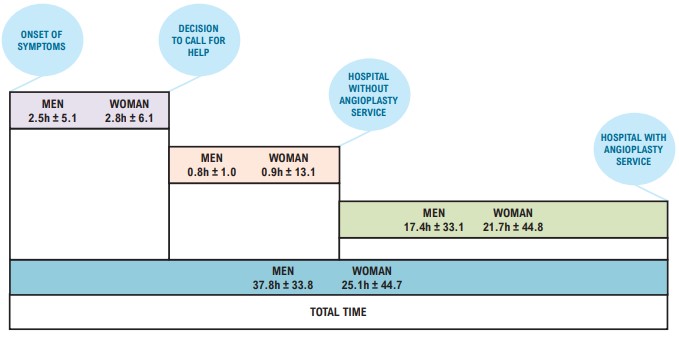Arq. Bras. Cardiol. 2021; 116(4): 695-703
Access to Reperfusion Therapy and Mortality in Women with ST-Segment–Elevation Myocardial Infarction: VICTIM Register
This Original Article is referred by the Short Editorial "Gender Equity in Access to Reperfusion in Acute Myocardial Infarction: Still A Long Way to Go".
Abstract
Background:
Myocardial reperfusion is a fundamental part of the treatment for ST elevation myocardial infarction (STEMI) and is responsible for reducing morbidity and mortality in affected patients. However, reperfusion rates are usually lower and mortality rates higher in women compared to men.
Objectives:
To evaluate the prevalence of the use of reperfusion therapies among women and men with STEMI in hospitals where percutaneous coronary intervention (PCI) is available in the state of Sergipe.
Methods:
This is a cross-sectional study that used data from the VICTIM Register. Patients diagnosed with STEMI admitted to the four hospitals (one public and three private) where PCI is available in the state of Sergipe were evaluated, from December 2014 to June 2018. A multivariate analysis with adjusted model using mortality as a dependent variable was made. In all analyses, the level of significance adopted was 5% (p < 0.05).
Results:
A total of 878 volunteers with a confirmed diagnosis of STEMI, of which 33.4% were women, were included in the study. Only 53.3% of the patients underwent myocardial reperfusion (134 women versus 334 men). Fibrinolysis was performed only in 2.3% of all patients (1.7% of women versus 2.6% of men; p = 0.422). The rate of primary PCI was lower (44% versus 54.5%; p = 0.003) and hospital mortality was higher (16.1% versus 6.7%; p < 0.001) in women than in men.
Conclusion:
Women have significantly lower rates of primary PCI and higher hospital mortality. Reperfusion rates were low in both sexes and there was a clear underutilization of thrombolytic agents.
1,107

